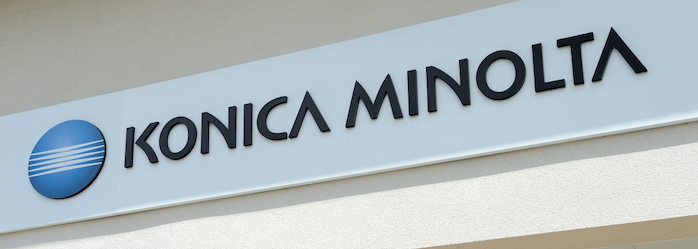Konica Minolta is a name that most people tend to associate with high-end photocopiers or cameras, but the company plays a substantial, if somewhat unsung, role in the graphic arts business. Its spectrophotometers and tristimulus colorimeters are used by printers world-wide on a daily basis. The company is now preparing to take a more ambitious step into the commercial and packaging print markets, with its first ink-jet printing press for commercial printers.
Konica Minolta Holdings is only a decade or so old and is the central management hub for Konica Minolta technologies, including the heads used in some wideformat digital systems, such as the Agfa Anapurna. The company is out of the camera business, focusing instead on its Bizhub line of MFPs and its production print engines. Increasingly, technology is shared across product lines and print products are sold alongside other business equipment.
This approach will provide Konica Minolta with a considerable advantage as businesses start to demand highquality color and reprographics. Competitors, such as Ricoh and HP, differentiate target markets in a way that is increasingly difficult to define. This segmentation is also confusing to manage in the field, making it an expensive model to support.
The Konica Minolta group’s first printing products for the graphic arts market were the series of Bizhub Pro light-production engines, introduced some years ago. Positioned to complement an offset press, they have helped it gain steady traction in the market, while partnerships with companies such as EFI, Objective Lune and DirectSmile have also helped. At drupa 2012 a technology preview brought Konica Minolta a step closer to the commercial print business.
The KM1 press combines Konica Minolta heads with a Komori chassis and paper transport. This sheet-fed B2 ink-jet device prints UV-LED inks onto offset papers, without pre- or post-treatment, at 1,200dpi. It has been in development for the last 15 years and will be previewed, along with its proper name, at Ipex 2014 in March. Since its initial preview, the technology has undergone substantial refinement in terms of head and ink performance, workflow management, feeding and finishing.
The machine is designed for offset printing applications and, according to Mark Hinder, Konica Minolta’s market development manager, it’s ‘a jointly developed product for B2 sheet-fed printing’. Hinder and his team will target a range of applications, including packaging, book printing and highend commercial work. The press prints heavy-weight stocks, so could be suitable for packaging applications. This is a cut-sheet device and, to support variable data reliably, it includes a special suction and vacuum belt and blowers to prevent double-sheet feeding.
Konica Minolta has developed a complete workflow system based on a RIP system that fully supports PDF and JDF. The company won’t say more than that the RIP is not Global Graphics technology, but the emphasis on variable data suggests that the RIP is based on Adobe APPE 3.0. This workflow system sounds quite intriguing as it is bespoke to the KM1: “We’ve been doing a lot of work about data; when we’re ready to launch it will be fully developed to [image] 3,300 sheets per hour simplex and 1,750 duplex.”
The KM1’s main competition is non-aqueous ink devices, such as the Fujifilm JetPress, the HP Indigo 10000 and the Screen TruePress. Japan, where the product development is taking place, will also be the source of details on the commercial availability of the KM1. As for compliance with ISO 12647-2, the international standard for quality production for offset printing, Hinder says, “It would be foolish of us not to include this consideration.”
We expect to hear more about this when the product is launched at Ipex. If the KM1 can match the targets specified in ISO 12647-2, then Konica Minolta will be the first developer of a digital press with a press that really can go to the heart of offset. This should scare the competition into upping their games, especially when it comes to ISO 12647-2 compliance.
Konica Minolta is also working on new technologies for the cut-sheet market, due for launch at Ipex, while it will also showcase a new toner for mid- to high-end production. All in all, it looks as though Konica Minolta really could take the graphic arts business by storm.
By Laurel Brunner – 11 March 2014


